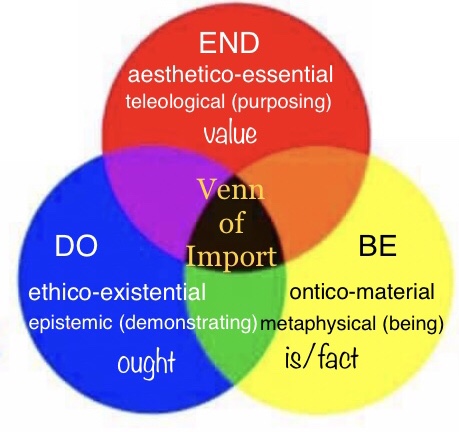A first attempt at being concise.
First, an introduction of C Theory and the Venn of Import, then an explanation of how C Theory is distinct from and resolves conflicts arising from A and B theories, using the Venn (or Harmonic Triad) of Import.
In the C Theory of Time, there are beings (like us) who are subject to Time (language from Kant), and there is Being who is Time. Time is not “Being Alone” (Parmenides, unless he meant…) but is “Being in Relation”. As the unchanging ground or source subsuming all being and change, Time is both immanent (omnitemporal) in and transcendent (transtemporal) over all temporality. The past is hyperthetical and the future is hypothetical from the perspective of beings subject to Time. From the perspective of the Being who is Time, the past, present, and future form an essential whole, the Metanarrative of Time. Every moment contains the story leading up to that moment, and implies the story that follows that moment. In that way, every moment is a synthesis between the past and the future, and the story began whole and is subsumed eternally in Time (see Hegel). The Metanarrative of Time is an expression or demonstration of the essential character of Time as “Being in Relation”. Without that demonstration, there would be nothing: no essence to demonstrate, no action (the demonstration), no being in which to demonstrate (see Plato). The matter and energy of every moment is the “stuff” upon which Time and (with Time’s permission and concurrence) beings subject to time “act” or move in order to bring about the full expression of the Metanarrative of Time in each moment. So, the story never changes from the perspective of the whole (Being who is Time), but the whole subsumes the changes necessary for beings subject to Time to freely participate with “Being in Relation”.

The Venn (or Harmonic Triad) of Import. There are three imports: END or essential (hyper-/hypo-aesthetical) import, DO/ACT or ethico-existential (action) import, and BE(ING) or ontologico-material (ontic) import. Note that “existential” import is usually used in the case of BE, not DO, but to prevent confusion, I restrict it to DO, and use “ontological” for BE. Other names for these imports would be teleological (purposing) import, epistemological (demonstrating) import, and metaphysical (being) import. The way I have said this mnemonically for years is: end, do, and be. END… as in… the end goal you have to have in mind (or else it is like a game into which you are “thrown”) before you even start playing the game. The end is hypothetical while you are advancing towards or falling away from it. The end is hyperthetical once you have reached it. DO… as in… how you demonstrate you are reaching the end, or at least existing. BE… as in… a winner. There is only one winner (Being-in-Relation who is Time) who always exists (acts) their essence (you may recognize this language from existentialist philosophers like Jean Paul Sartre). Other names for these imports are value, ought, and fact/is, and you must clearly distinguish between them or you commit fallacies like the is-ought fallacy. The Venn of Import is relevant in every field of study.
The C Theory of Time is unlike A Theory because A Theory only acknowledges the essential status of the present moment, disregarding the essential status of the past and future as part of the whole Metanarrative of Time that began complete. C Theory is unlike B Theory because B Theory elevates every moment to the hyperthetical status of the past, disregarding that the changes subsumed by Being who is Time are necessary for beings subject to Time to freely participate with/in “Being in Relation” – a willful demonstration of essence that would not rightly be said to exist (in action or being) without such demonstration. Prior to the demonstration to beings subject to Time, the demonstration has hypothetical (essential) import if ontologically grounded in Being-in-Relation who is Time. Without such grounding, there would have been no demonstration of essence, and no essence (being-in-relation) to demonstrate. Another way to say “being-in-relation” is the recognition that every self is an other to another self. The demonstration acknowledges/communicates that recognition to beings subject to Time so they can likewise communicate it in their values (end, or essential import), actions (do, or existential import), and the character of their thoughts (be, or ontological import)–if they so choose.